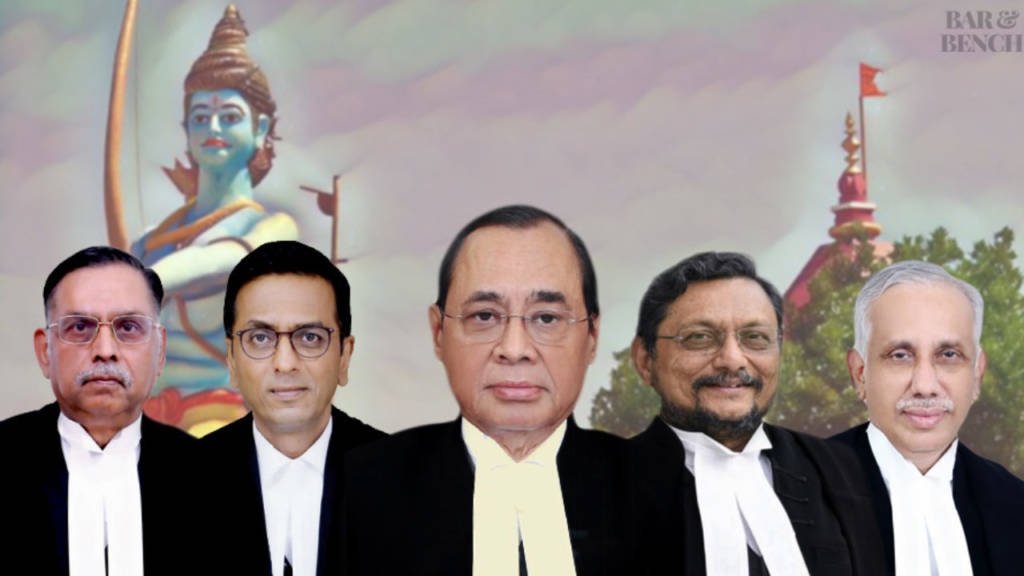In a landmark judgment, the CJI Gogoi led five-judge bench of the Supreme Court has pronounced its verdict on the Ayodhya dispute, which has conclusively settled this five centuries-old dispute, which was languishing in the Courts since 1885 when the matter first came up before the Faizabad District Court.
The bench consisting of CJI Ranjan Gogoi, Next CJI Justice SA Bobde, Justice Ashok Bhushan, Justice DY Chandrachud and Justice Abdul Nazeer ruled that the entire disputed 2.77-acre land should go to the Hindus, whereas the Muslims have been given 5 acres of alternate land.
This verdict shows that the Supreme Court has taken a meticulously sensitive and balanced approach to decide the dispute. The apex court decided the dispute on purely legal principles. As Chief Justice of India, Gogoi said that it is inappropriate for the Court to get into the area of theology.
Therefore, the judgment is based strongly on settled legal principles, and moreover the approach taken by the apex court is such that it is not about just decreeing the dispute in favour of one party and against the other. Rather, by allocating 5 acres of alternate land to the Muslim parties, the Supreme Court has taken a very balanced approach.
A trust is to be created by the Centre to monitor the construction of the temple. The Centre will within a period of three months formulate the scheme for constituting a trust that will monitor the construction of a Ram Temple at Ayodhya. Moreover, if the Centre decides, appropriate representation can be be given to the Nirmohi Akhara, a party representing the Hindu side in the Ayodhya matter before the Court in the Ayodhya dispute, in the scheme by the Board of Trustees.
The apex court made some key observations in arriving at the verdict. It held that the Babri Masjid was not constructed on vacant land. It also held that the underlying structure was a non-Islamic structure. The Supreme Court relied upon the ASI report to arrive at these conclusions and observations. Another key observation made by the Chief Justice of India, Ranjan Gogoi was that the faith of Hindus that Lord Ram was born in Ayodhya is undisputed.
He observed that the faith and the belief of the Hindus that Lord Ram was born in the inner dome is undisputed belief of Hindus. He made it clear that once the faith is genuine, the Courts should not interfere. The Court also held that the historical accounts indicate the belief of the Hindus that Ayodhya was the birthplace of Lord Ram.
The Chief Justice of India, Ranjan Gogoi also stated that the right of Ram Lalla to the disputed property is subject to the maintenance of peace and law and order and tranquillity. Government is required to take necessary measures for maintaining peace and harmony and order. This shows the concern of the Supreme Court to not only effectively and conclusively decide the dispute, but also to ensure that anti-social elements are not able to fuel tensions within the country by inciting passions against the verdict.
What PM Modi tweeted about this historical development also captures the essence of the apex court verdict. He said, “The Honourable Supreme Court has given its verdict on the Ayodhya issue. This verdict shouldn’t be seen as a win or loss for anybody. Be it Ram Bhakti or Rahim Bhakti, it is imperative that we strengthen the spirit of Rashtra Bhakti. May peace and harmony prevail!”
The Honourable Supreme Court has given its verdict on the Ayodhya issue. This verdict shouldn’t be seen as a win or loss for anybody.
Be it Ram Bhakti or Rahim Bhakti, it is imperative that we strengthen the spirit of Rashtra Bhakti.
May peace and harmony prevail!
— Narendra Modi (@narendramodi) November 9, 2019
The disputed site has thus been decreed in the favour of the deity. What makes this judgment that much more historic is the fact that it has been pronounced unanimously by the Constitution bench of the Supreme Court. This is a judgment based on sound and settled legal principles. This is a sound, legitimate, and balanced judgment. The fact that the Constitution bench of the apex court has given a unanimous verdict which shows that it was not biased or prejudiced in any manner.
Looking at the composition of the apex court bench, no one can make allegations of the being biased, politically or religiously. The five-judge bench consisted of Justice Abdul Nazeer, who also concurred with the unanimous verdict showing that there is no real infirmity in the apex court decision. The purpose here is not to look at the faith of the Hon’ble Supreme Court judge, but to point out that it is a purely balanced and sensitive verdict that the top court has given. The CJI Gogoi led Constitution bench deserves to be praised for this historic verdict, which has settled a centuries-old dispute in the most sensitive and responsible manner possible.
